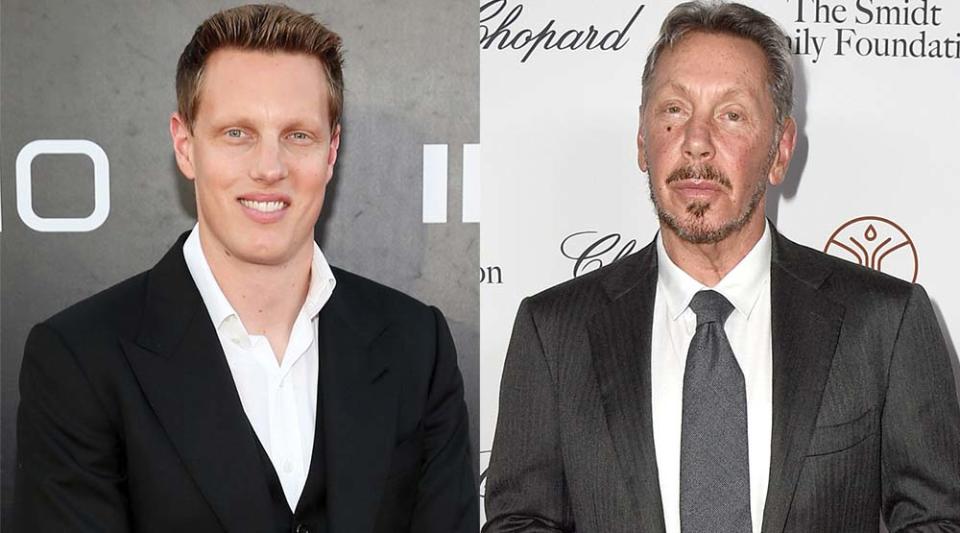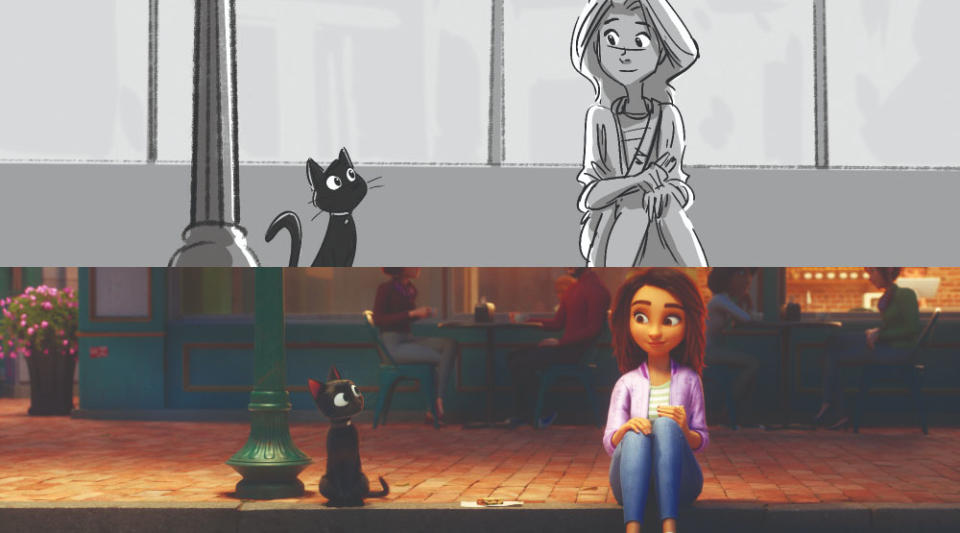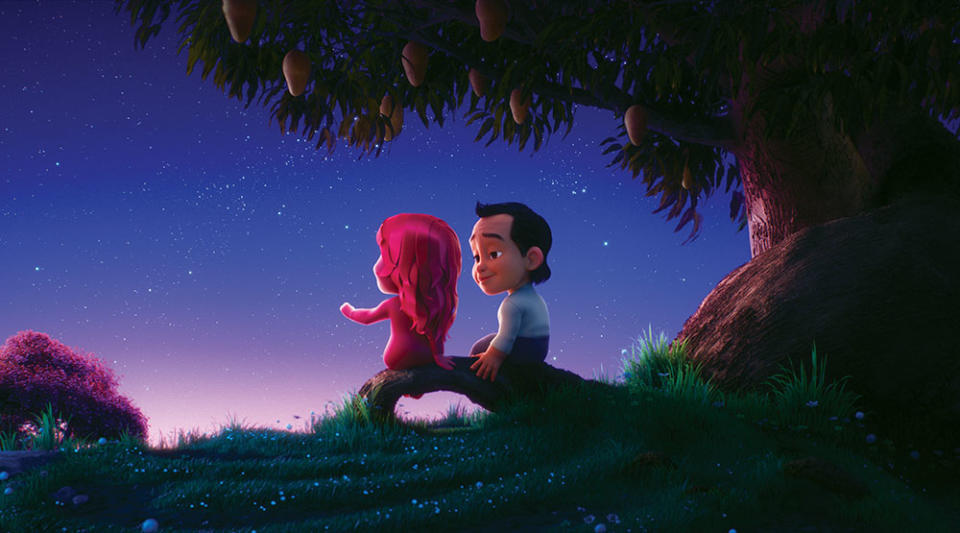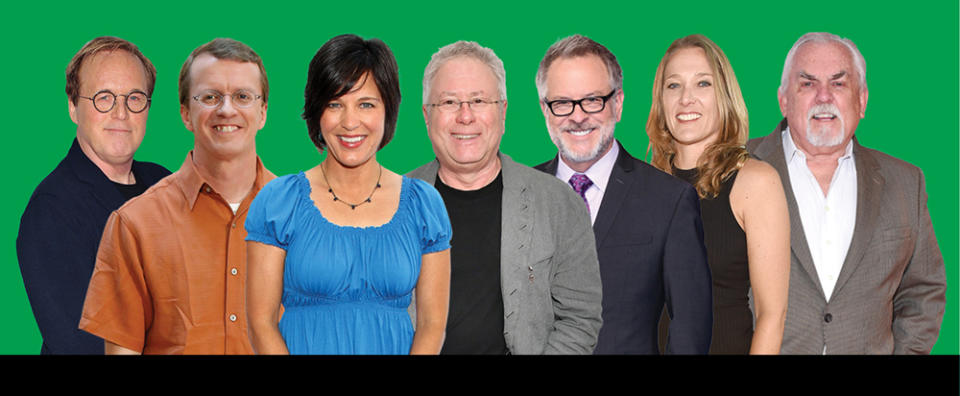John Lasseter’s Second Act
- Oops!Something went wrong.Please try again later.
- Oops!Something went wrong.Please try again later.
- Oops!Something went wrong.Please try again later.

In early 2020 while preparing to direct Luck, Skydance Animation’s first feature film, Peggy Holmes met with some unlikely consultants on the story. The lead character in Luck, an unlucky yet indomitable young woman named Sam, has grown up in foster care, and so Holmes interviewed kids with similar experiences in Ventura County, California, to better understand their perspective and help find the emotional core of Sam’s story. “We met with these young people and they shared their stories with us, and we were so incredibly moved by their positivity, their generosity, their never-give-up kind of attitude,” Holmes says. “These are people who have had some real bad luck in their lives. We wanted to honor that bravery.”
It’s the kind of creativity-sparking, empathy-building research that became common in the field of animation after it gained currency at Pixar and Walt Disney Animation Studios under their former chief creative, John Lasseter, who encouraged filmmakers to travel to Scotland for Brave and the South Pacific for Moana. Such excursions are among the signatures Lasseter took with him to Skydance, where he was — controversially — named head of the studio’s animation unit in early 2019. Lasseter also carried over the concept of a collective story trust, a group of thinkers at the studio who workshop each other’s films together. And he brought on Holmes, with whom he had worked when she directed two films at the now-defunct Disneytoon studios, as well as the writer of Luck, Kiel Murray, a former Pixar colleague.
More from The Hollywood Reporter
Tom Hanks Reacts to Tim Allen's 'Lightyear' Absence: "I Don't Understand That"
Tim Allen Addresses 'Lightyear' Debate: "I Wish There Was a Better Connection" to 'Toy Story' Films
Lasseter is a lion in his field. He directed 1995’s groundbreaking Toy Story (the first computer-animated feature film), propelled Pixar to two best picture Oscar nominations (for Up and Toy Story 3) and $6 billion in domestic box office, and reinvigorated a foundering Walt Disney Animation Studios. But his reign came to an abrupt end when he resigned from Disney in 2018, roughly six months after acknowledging what he described as “missteps” that made some Disney-Pixar staff members feel “disrespected or uncomfortable,” in a 2017 memo to staff. Employee complaints included unwanted hugging and implicit bias.
When Skydance CEO David Ellison hired Lasseter to run his then 2-year-old animation studio in 2019, replacing then-chief Bill Damaschke, the move sparked fierce protests. In a letter to members, Marge Dean, the head of the organization Women in Animation, said she was “shocked and distressed” and actress Emma Thompson backed out of a voice role in Luck, then under director Alessandro Carloni, citing “Mr. Lasseter’s pattern of misconduct.”

In the three years since, however, Lasseter and Skydance Animation have been quietly building an independent animation studio modeled on some of the same principles that drove Pixar in its early days under co-founder Steve Jobs — namely the idea that excellence is the best business strategy.
With Luck, which premieres Aug. 5 on Apple TV+, the studio will unveil its creative ambitions and Lasseter’s next act, which will be closely watched by the professional animation community and diehard Disney/Pixar fans.
Since Lasseter arrived, Skydance Animation has grown from 65 employees to nearly 900, acquired the animation unit of Madrid-based Ilion Studios (Wonder Park, Planet 51), and set a multiyear film and TV deal with Apple. Lasseter has also lured some of Pixar and Disney’s top, Oscar-winning talent, including The Incredibles director Brad Bird, who is at work on his movie Ray Gunn for Skydance; Zootopia director Rich Moore, who signed an exclusive deal with the studio this spring; and Beauty and the Beast composer Alan Menken, who is writing the music for the studio’s sophomore feature, Spellbound.
“David really wanted to build the next great animation studio,” says Lasseter, in one of his first interviews since his departure from Disney, which he declined to discuss. “I was excited because it could be something small and nimble. I found that this was a great home for me, and that we could build something pretty special, get the best talent in the world, and come together and aim to the level I’ve always aimed for.”

Given the critiques that surrounded Lasseter’s departure from Disney, it’s noteworthy that the directors of Skydance Animation’s first two films, Luck and Spellbound, are women: Holmes and Vicky Jenson, respectively. “I can’t speak for other people, but I can say my working relationship with John feels just as it did before, in that he is a really great mentor,” says Holmes. “He’s a master storyteller and he is very generous with his ideas and his time.”
The outrage that greeted Lasseter’s hiring has quieted, at least publicly, but some in animation remain skeptical about his return. “I’m less angry now,” says Ashlyn Anstee, a director at Cartoon Network. “It’s more letting a so-called creative genius continue to take up positions and space in an industry that could begin to be filled with different people. I wish the leadership above Lasseter would take a look at what they’re valuing and what they’re willing to take a chance on.”
Ellison’s recruitment of Lasseter stems from the Skydance CEO’s own formative film experiences. As a child, David, the son of Oracle founder Larry Ellison, had a front-row seat to watch Pixar’s creation because of his father’s close friendship with Jobs. Before Toy Story arrived in theaters when he was 12, David had seen 70 cuts of the film; he saw even more cuts of Finding Nemo, which hit theaters when he was 20. “I got to watch all of this when I was a kid and completely fell in love, and always admired how high they always aimed creatively,” Ellison says. “Everything Steve and John built together at Pixar lasted.”
After Lasseter’s resignation from Disney, Ellison reached out to him through the lawyer they share, Skip Brittenham. Lasseter’s Disney departure occurred in the heat of the #MeToo movement, after egregious and specific revelations about other powerful Hollywood figures like Harvey Weinstein and Bill Cosby, and media reports about Lasseter often linked him with those men. In Lasseter’s case, there were no charges of sexual assault, nor, according to Ellison, who hired attorneys to scrutinize the claims, settlements made by Lasseter or on his behalf.
Ellison privately decided that Lasseter was not only employable, but a potentially transformative leader for his new animation company. Since then, Ellison has conceded that he mishandled the announcement of the hire and should have been more transparent to and inclusive of his employees in making the decision. The studio held town hall meetings for employees, some of which were heated during that uncertain time. “I certainly was apprehensive, as I had never met John before,” says Skydance Animation president Holly Edwards. “Once he was here and we had a chance to talk about what kind of studio we wanted Skydance Animation to be, I realized we were working toward the same thing.” Filmmakers with existing projects pitched Lasseter their ideas. “I remember him describing what he loved about the movies that we were already making,” says Jenson.
Luck was well underway when Lasseter arrived at Skydance in 2019, and the studio had already sunk millions into it. The final budget is more than $140 million, according to a studio source, but less than that of a typical Disney or Pixar animated movie, which usually exceeds $200 million. Lasseter recruited Holmes, an Emmy winner whose credits include Disneytoon’s Secret of the Wings and The Pirate Fairy, to work on a series at Skydance, but within eight months of her arrival, he replaced Carloni and installed Holmes as the new director of Luck, which underwent a dramatic story change, including adding new characters and the idea of the protagonist’s search for a forever family.
“I knew it would be challenging because we had to kind of take it back down to the beginning and rebuild it and do it in a pretty short amount of time,” explains Lasseter. “Peggy is a crazy-great story mind, and Peggy has a gigantic heart, and when we were reconceiving Luck, I knew she was exactly the right person to do it.” In the spring of 2019, Lasseter brought in Murray, who was a writer on Cars, to also work on the story.
Luck opens as lead character Sam Greenfield, voiced by Eva Noblezada, turns 18, moves to her first apartment and begins her first job. Everything about Sam’s day goes wrong until she finds a lucky penny and meets a mysterious black cat (Simon Pegg), who leads her to the Land of Luck, where both good and bad luck are manufactured. The film’s animation is highly stylized and its world richly detailed — populated by places like the R&D centers for “Happy Accidents” in the realm of Good Luck or “Computer Keeps Crashing” in Bad Luck. The starry voice cast features some prominent Hollywood feminists, including Jane Fonda as the CEO of Good Luck and Whoopi Goldberg as a manager of leprechauns.
After Holmes came aboard, “it became a much more magical story,” says Murray. “When Peggy and I started working on it, it clearly shifted to be more about love, [with] good and bad luck sort of the container that the love was going to be fitting in. Love was the luckiest thing.”
Skydance is best known for producing live-action films like Top Gun: Maverick and much of the Mission: Impossible franchise, and Lasseter brought with him the particular knowledge of animation production. “He’s been fantastic to help educate Skydance, which came out of huge action pictures,” says Jenson, the director of DreamWorks Animation’s Shrek, who joined the studio before Lasseter arrived. “Animation is more iterative and more layered.” For such a high-level executive, Lasseter has a hands-on style. “He loves to roll up his sleeves and get into the nitty-gritty of things,” says Edwards. “Those were some of his happiest moments, when he could really get into the details of the sequences and shape them.”
Some former Skydance Animation employees say Lasseter’s working style is too controlling, however — that he insists on approving minor details and creates a bottleneck in the workflow. He prefers to have scripts read to him, former employees say, and sometimes falls asleep during those readings, only to later criticize the story for plot holes he missed while asleep. “He couldn’t remember what happened in the last meeting,” says one former Skydance Animation employee. “Things would change on a whim based on what he thought he remembered.” A representative from the studio spoke to several people who were on the alleged Zoom meetings, and those people say they never witnessed Lasseter falling asleep. One employee says that after 18-hour days while crashing a deadline for a movie, “all of us would zone out.”
Ex-employees also complained that Lasseter’s son, short-film director Bennett Lasseter, brought on as a consultant on the TV show The Search for WondLa, was giving notes on scripts. The studio’s deal with Apple includes two seasons of WondLa, the only TV series Skydance Animation has announced, which is based on the children’s book series by Tony DiTerlizzi. Its original showrunner, Lauren Montgomery, left the project and has been replaced by Bobs Gannaway, another of Lasseter’s Disney-era colleagues.
Skydance Animation’s next film, Spellbound, will be a musical. To compose its songs, Lasseter suggested marquee Disney composer Menken, who has won eight competitive Oscars, the most of any living person. The film, which was once going to be titled The Unbreakable Spell, revolves around Princess Ellian, voiced by Rachel Zegler, and her parents the King and Queen (Javier Bardem and Nicole Kidman), who inhabit a cursed kingdom. Jenson began directing from a script by Linda Woolverton (1991’s Beauty and the Beast). Upon Lasseter’s arrival, Lauren Hynek and Elizabeth Martin, of the 2020 live-action Disney film Mulan, joined the project as additional writers.
Skydance Animation’s next two projects under the Apple deal are from directors who have worked with Lasseter in the past: Pookoo, helmed by Nathan Greno, who co-directed Disney’s Tangled; and Ray Gunn, directed by Bird. In joining Skydance, Bird — a two-time Oscar winner for Pixar’s The Incredibles and Ratatouille — reteamed not only with Lasseter but also with David Ellison and Skydance chief creative officer Dana Goldberg, for whom he helmed Skydance’s Mission: Impossible — Ghost Protocol. Bird says he valued the access to leadership at Skydance. “To be able to go directly to the head of the company with any concerns and have a human face on it — somebody that is not a committee, [Ellison] is a guy that loves movies — that’s really rare nowadays.”
Bird started developing the story for Ray Gunn in the late ’90s at what was then Turner Feature Animation, which merged with Warner Bros. The new studio asked Bird to switch gears and offered him the opportunity to instead helm The Iron Giant. But Bird never forgot the project, and says he recently negotiated for the rights to the material, telling Warner Bros., “Either let’s make it or let me try to make it somewhere else.” He signed a deal to make the film with Skydance in 2021.
Bird describes Ray Gunn as a more adult project in the noir genre, “sort of a detective film in an alternate future” that follows protagonist Raymond Gunn. “If you mashed up The Maltese Falcon with Buck Rogers, it might be something like that. But hopefully with a bit more action and funnier.” When he arrived at Skydance, Bird reassembled some of his longtime collaborators, including Oscar-winning composer Michael Giacchino, character designers Teddy Newton and Tony Fucile, editor Darren T. Holmes and storyboard artist Jeff Lynch.
Ellison and Lasseter plan for Skydance Animation to make two feature films a year, with their theatrical strategy to be determined on a film-by-film basis. The company is also building a consumer products team to capitalize on its potential successes and will begin to open a 5.8-acre Santa Monica campus in October, expected to be completed by November 2023.
As the company grows, some in animation say they’re taking a wait-and-see attitude toward Skydance and Lasseter. An early showcase for the studio came in 2021 with the short film Blush, a sophisticated allegory about Filipino American filmmaker Joe Mateo’s loss of his wife to cancer. Lasseter was closely involved with the short, which the studio conceived as a way to integrate its L.A. and Madrid teams on a project. Despite its artistic ambitions, Blush didn’t make the Oscar shortlist, which could be a function of Skydance’s newness on the animation scene, the reflection of a Lasseter backlash or the result of the sometimes-mercurial tastes of the Academy committee that selects the animated shorts, which is often composed of many live-action-short filmmakers.

Whether the awards follow or not, for Lasseter, Blush and Luck serve a key function in communicating his studio’s intentions to the animation community. With streaming services creating heavy demand for product, animation recruiting is fierce, and Skydance has found staff in far-flung places, including Connecticut, hiring former employees of Blue Sky Animation, the studio that made the Ice Age films before it was acquired and dismantled by Disney in the Fox merger.
“Blush was done for many, many reasons, but recruiting was part of it. So we could have a calling card out there,” Lasseter says. “When we say quality, this is what we mean by quality. This is what we’re aiming for, not only in the way things look and the animation, but the story and the emotion. I’m hoping with Luck that people will start looking at the studio, going, ‘I love those films. I want to go work there.’ “
***
Putting the Band Back Together
Skydance Animation has brought on scores of Lasseter’s former collaborators from Disney and Pixar. Among them …
Brad Bird
Ray Gunn director Bird is a two-time Oscar winner, for Pixar’s The Incredibles and Ratatouille. Bird, a Simpsons alum, was classmates with Lasseter at CalArts.
Bobs Gannaway
The Search for WondLa showrunner spent more than two decades at Disney as a writer, director and producer on series including House of Mouse, Timon & Pumbaa and 101 Dalmatians.
Peggy Holmes
Luck director Holmes, who won an Emmy as a choreographer (for Fame L.A.), helmed The Pirate Fairy and Secret of the Wings from Disney’s Fairies franchise.
Alan Menken
Spellbound composer Menken is an eight-time Oscar winner and EGOT who wrote scores and songs for Disney animated movies including The Little Mermaid, Beauty and the Beast and Aladdin.
Rich Moore
Moore, who signed an exclusive deal with Skydance, helmed Disney Animation’s Wreck-It Ralph and Ralph Breaks the Internet, and won an Oscar for Zootopia.
Kiel Murray
Luck writer Murray worked on the screenplay for Pixar’s Oscar-nominated Cars, which was directed by Lasseter. She also wrote for Disney Animation on Raya and the Last Dragon.
John Ratzenberger
Ratzenberger has voiced characters in every Pixar movie from 1995’s Toy Story to 2020’s Onward, earning the nickname “Pixar’s Lucky Charm.” In Luck, he plays Rootie, the unofficial mayor of the Land of Bad Luck.

This story first appeared in the July 27 issue of The Hollywood Reporter magazine. Click here to subscribe.
Best of The Hollywood Reporter

